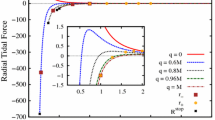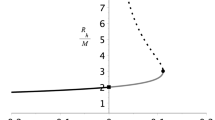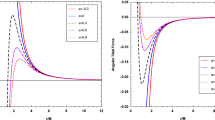Abstract
The aim of this paper is to investigate tidal forces in multidimensional spherically simmetric spacetimes. We consider geodesic deviation equation in Schwarzschild–Tangherlini metric and its electrically charged version. We show that these equations can be solved explicity for radial geodesics as quadratures in spaces of any dimension. In the cases of five, six and seven dimensional spaces, these solutions can be represented in terms of elliptic integrals. For spacetimes of higher dimension asymptotics of the solution are found instead. We established that the greater the dimension of space is, the stronger the tidal stretch along the radial direction in the vicinity of physical singularity is, whereas the tidal compression in direction transverse to the radial one, does not change in the leading order starting from a certain dimension. Also, in the case of non-radial geodesics, the presence of black hole electric charge does not affect the force of transverse compression in the leading order. Finally, for non-radial geodesics with nonzero angular momentum, the local properties of solutions of geodesic deviation equations in the vicinity of a singularity are studied.
Similar content being viewed by others
References
H Fush Ann. Physik 495 231 (1983).
K Schwarzschild and B Sitzungsbesichte Phys. Math. Klasse 189 (1916)
S L Bazanski and P J Jaranowski Math. Phys. 30 1794 (1989).
J P Luminet and J A Marck Mon. Not. R. Astron. Soc. 212 57 (1985).
V P Vandeev and A N Semenova Eur. Phys. J. Plus 137 185 (2022).
H Reissner Ann. Physik 50 106 (1916).
G Nordström Proc. Kon. Ned. Akad. Wet. 20 1238 (1918).
L C B Crispino et al Eur. Phys. J. C 76 168 (2016).
F Kottler Ann. Physik 56 401 (1918).
V P Vandeev and A N Semenova Eur. Phys. J. C 81 610 (2021).
M Cariglia, T Houri, P Krtouš et al Eur. Phys. J. C 78 661 (2018).
M U Shahzad and A Jawad Eur. Phys. J. C 77 372 (2017).
V V Kiselev Class. Quant. Grav. 20 1187 (2003).
H C D Lima Junior, M M Correa, C F B Macedo et al Eur. Phys. J. C 82 479 (2022).
M Sharif and S Sadiq JETP 153 232 (2018).
H C Lima and L C Crispino Int. J. Mod. Phys. D 29 2041014 (2020).
A Goel, R Maity, P Roy and T Sarkar Phys. Rev. D 91 104029 (2015).
S Madan and P Bambhaniya, https://doi.org/10.48550/arXiv.2201.13163.
Soon-Tae Hong et al Phys. Lett. B 881 135967 (2020).
Jing Li et al Eur. Phys. J. C 81 590 (2021).
J Liu, S Chen and J Jing Chin. Phys. C 46 105104 (2022).
R P Kerr Phys. Rev. Lett. 11 237 (1963).
H C Lima and L C Crispino Eur. Phys. J. Plus 135 334 (2020).
R Uniyal Eur. Phys. J. C 82 567 (2022).
C Chicone, B Mashhoon and B Punsly Int. J. Mod. Phys. D 13 945 (2004).
C Chicone and B Mashhoon Ann. Phys. 14 290 (2005).
D Bini, C Chicone and B Mashhoon Phys. Rev. D 95 104029 (2017).
M F Shirokov Gen. Rel. Grav. 4 131 (1973).
A Nduka Gen. Rel. Grav. 8 347 (1977).
E Y Melkumova et al Sov. Phys. J. 33 349 (1990).
D Philipp, V Perlick, C Lammerzahl and K Deshpande IEEE Metrol. Aerosp. (MetroAeroSp.) 2015 198 (2015).
F R Tangherlini Nuovo Cim. 27 636 (1963).
C W Misner, K S Thorne and J A Wheeler Gravitation (San Francisco: W.H. Freeman) (1973)
D E Hodgkinson Gen. Rel. Grav. 3 351 (1972).
Acknowledgements
We would like to express our gratitude to Yuri Viktorovich Pavlov and Polina Igorevna Kakin for meaningful discussions and useful advice.
Author information
Authors and Affiliations
Corresponding author
Additional information
Publisher's Note
Springer Nature remains neutral with regard to jurisdictional claims in published maps and institutional affiliations.
Appendices
Fuchs’ equations and Frobenius method
Second-order differential equation for a complex variable function y(z)
has a regular singular point at \(z=z_0\), if the coefficients p(z), q(z) have pole at \(z=z_0\) not higher than the first and second order, respectively. In other words, the coefficients are decomposed into Laurent series as follows:
In the vicinity of a regular singular point \(z=z_0\) two linearly independent solutions of Eq. (80) can be found using the generalized series
where \(\zeta _1\) and \(\zeta _2\) are roots of quadratic equation
If difference \(\zeta _1-\zeta _2\) is not integer, then both solutions of Eq. (80) coincide with the power series (82), but if difference \(\zeta _1~-~\zeta _2\) is positive integer, then the first solution for higher \(\zeta _1\) remains the same (82a) while the second linearly independent solution has another form
Elliptic integrals
The simplest indefinite elliptic integral is the expression
where \(y(z)=\sqrt{a_0+a_1z+a_2z^2+a_3z^3+a_4z^4}\) and R(z, y) is rational function of two variables. Any elliptic integral can be brought to the form
where \(R_1(z)\) and \(R_2(z)\) are rational functions of one variable. Linear fractional transformation
can turn the second term of (86) into
where \(\tilde{R}_2(x)\) is another rational function, and \(\tilde{y}(x)\) is reduced to Weierstrass form
or Legendre form
As a result, expression (88) can be represented as a sum of integrals of three kinds.
-
In Weierstrass form integrals of three kinds are
$$\begin{aligned} J_0(x|g_2,g_3)= & \int \frac{\textrm{d}x}{\sqrt{4x^3-g_2x-g_3}}, \end{aligned}$$(91a)$$\begin{aligned} J_1(x|g_2,g_3)= & \int \frac{x\textrm{d}x}{\sqrt{4x^3-g_2x-g_3}}, \end{aligned}$$(91b)$$\begin{aligned} H(x|g_2,g_3)= & \int \frac{\textrm{d}x}{(x-c)\sqrt{4x^3-g_2x-g_3}}. \end{aligned}$$(91c) -
In Legendre form integrals of three kinds are
$$\begin{aligned} F(x,k)= & \int \frac{\textrm{d}x}{\sqrt{\left( 1-x^2\right) \left( 1-k^2x^2\right) }}, \end{aligned}$$(92a)$$\begin{aligned} E(x,k)= & \int \sqrt{\frac{1-k^2x^2}{1-x^2}}\textrm{d}x, \end{aligned}$$(92b)$$\begin{aligned} \Pi (x,k,c)= & \int \frac{\textrm{d}x}{\left( 1-\frac{x^2}{c^2}\right) \sqrt{\left( 1-x^2\right) \left( 1-k^2x^2\right) }}. \end{aligned}$$(92c)
Where c is some pole of the function \(\tilde{R}_2(x)\), which can be complex.
Rights and permissions
Springer Nature or its licensor (e.g. a society or other partner) holds exclusive rights to this article under a publishing agreement with the author(s) or other rightsholder(s); author self-archiving of the accepted manuscript version of this article is solely governed by the terms of such publishing agreement and applicable law.
About this article
Cite this article
Vandeev, V.P., Semenova, A.N. Tidal properties of D-dimensional Tangherlini black holes. Indian J Phys 97, 1947–1957 (2023). https://doi.org/10.1007/s12648-022-02543-5
Received:
Accepted:
Published:
Issue Date:
DOI: https://doi.org/10.1007/s12648-022-02543-5




